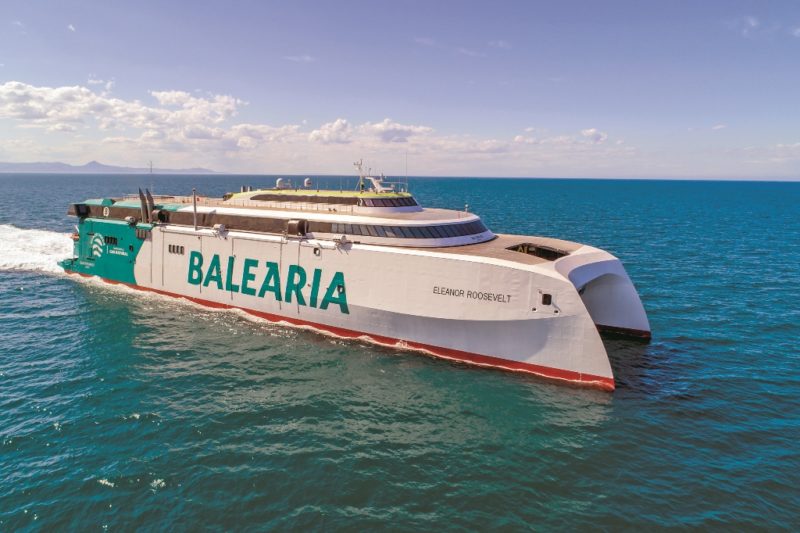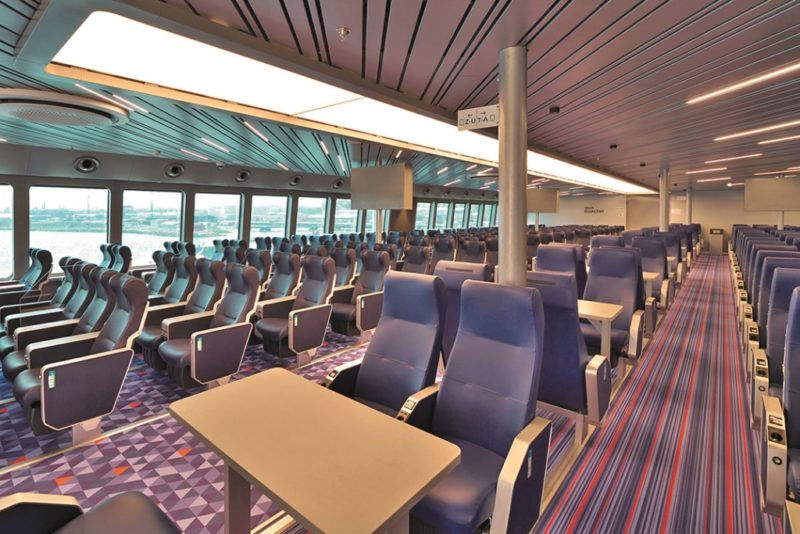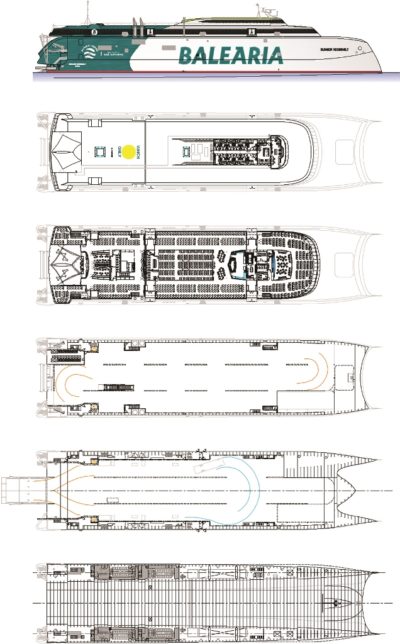 Incat Crowther has an impressive array of fast ferry designs in its portfolio and its largest yet is the Incat Crowther 123 passenger and vehicle catamaran, delivered to Spanish ferry operator Balearia in May 2021. The Marine Engineering Design company was created from a merger of Incat Designs (Sydney) and Crowther Designs in 2005. Crowther Designs had a history in catamaran, trimaran and commercial vessel design whilst Incat Designs (Sydney) was formed in 1988 with its roots going back to 1977 when a partnership, namely International Catamaran Pty Ltd., was formed to design and build catamarans in Tasmania. This combination made significant advances in fast powered catamaran technology culminating in the wave piercing catamarans. In early 1988, the shipyard partnership was mutually terminated and a design-only company was formed, later to become Incat Designs (Sydney) whilst the other partner from International Catamaran Pty Ltd. was Robert Clifford, who then commenced designing and building under a new company, Incat Tasmania Pty Ltd. Worldwide, over 600 vessels built to Incat Crowther designs have been delivered to date with examples in the U.K to be found serving Red Funnel Ferries (363gt/2016-built Red Jet 6/363gt/2018-built Red Jet 7) and members of the Uber Thames Clippers fleet including the 172gt/2019-built Venus Clipper.
Incat Crowther has an impressive array of fast ferry designs in its portfolio and its largest yet is the Incat Crowther 123 passenger and vehicle catamaran, delivered to Spanish ferry operator Balearia in May 2021. The Marine Engineering Design company was created from a merger of Incat Designs (Sydney) and Crowther Designs in 2005. Crowther Designs had a history in catamaran, trimaran and commercial vessel design whilst Incat Designs (Sydney) was formed in 1988 with its roots going back to 1977 when a partnership, namely International Catamaran Pty Ltd., was formed to design and build catamarans in Tasmania. This combination made significant advances in fast powered catamaran technology culminating in the wave piercing catamarans. In early 1988, the shipyard partnership was mutually terminated and a design-only company was formed, later to become Incat Designs (Sydney) whilst the other partner from International Catamaran Pty Ltd. was Robert Clifford, who then commenced designing and building under a new company, Incat Tasmania Pty Ltd. Worldwide, over 600 vessels built to Incat Crowther designs have been delivered to date with examples in the U.K to be found serving Red Funnel Ferries (363gt/2016-built Red Jet 6/363gt/2018-built Red Jet 7) and members of the Uber Thames Clippers fleet including the 172gt/2019-built Venus Clipper.
First Lady
The new ground-breaking vessel was ordered by Spanish ferry operator Baleària, which is the trading name for Baleària Eurolíneas Marítimas S.A. The company operates passenger ferry services in the Mediterranean and Caribbean and was founded by Adolfo Utor Martínez in 1998. In The Mediterranean services include domestic routes within Spain to the Balearic Islands (Mallorca/Menorca/ Formentera/Ibiza) from Dénia, Valencia and Barcelona plus international services across the Strait of Gibraltar from Algeciras to Ceuta and Tangier in times when there are no pandemic restrictions or political squabbles. Baleària also operates a regular international ferry service between the port of Fort Lauderdale, Florida in the U.S.A and Freeport, Grand Bahama Island, Bahamas. The number of vessels in the fleet fluctuates but in 2021 fleet strength was 24 for the European and USA operations combined. The fast ferry newbuild was ordered in October 2018, formally announced on 1st November 2018 and was unveiled at the FITUR international tourism fair in Madrid in January 2019. The striking profile of the Incat Crowther 123 design reminds the Writer of the Stealth Ship (Sea Dolphin II), a fictional radar and sonar resistant catamaran-style stealth vessel constructed by media mogul Elliot Carver, the villain in the 1997 James Bond film Tomorrow Never Dies. This vessel had herself been inspired by the hi-tech stealth vessel built by the U.S Government in 1984, was named Sea Shadow. She undertook stealth characteristic trials for future naval programmes and it was 9 years before her existence was revealed to the general public. There are also shorter versions of this design in operation/in-build from Austal in Australia. The very first was Molslinjen’s 11,345gt/2019-built Express 4 (Hull 393/Auto Express 109 design), larger 115m and 13,859gt/2022-built sister vessel Express 5 (Auto Express 115 design), Trinidad & Tobago’s 6,542gt/2020-built A.P.T James (Hull 397/Auto Express 94. design) and the 11,888gt/2021-built Fjord FSTR (Hull 419/Auto Express 109 design). Besides being the first 123m long variant (stated as the world’s longest fast ferry), the Balearia newbuild would also be the world’s first very large catamaran Ro-Pax ferry powered by dual-fuel reciprocating engines. To add to the ‘Firsts’, the €90 million ferry had the name Eleanor Roosevelt bestowed upon her as a tribute to the writer, gender equality activist and advocate for the civil rights of African and Asian Americans and refugees from World War II that was Anna Eleanor Roosevelt (11th October 1884-7th November 1962), an American political figure. She served as the First Lady of the U.S.A from 4th March 1933 to 12th April 1945 during her husband President Franklin D. Roosevelt’s four terms in office, making her the longest-serving First Lady of the U.S.A. She also served as United States Delegate to the United Nations General Assembly 1945-1952. The Eleanor Roosevelt is Balearia’s 6th ship to pay tribute to pioneering women in their respective disciplines, in accordance with their commitment to one of the sustainable development goals, equality and the empowerment of women.
The other fleet members to carry names in this series are as follows:
The 5,989gt/1999-built Cecilia Payne, named after the Anglo-American astronomer and astrophysicist Cecilia Payne (born 1925), whose thesis was a major breakthrough in the study of the stars, as she was the first person to determine that they are composed primarily of hydrogen. This Austal-built craft was previously Irish Ferries’ Jonathan Swift.
The 26,375gt/2010-built Hedy Lamarr, named after the Austrian woman who invented the first version of the spread spectrum that enabled long-distance wireless communications. She was also an actress and director. This Ro-Pax ship was previously the Visemar One.
The 28,658gt/2019-built Hypatia de Alejandria, named after the philosopher Hypatia, a native of Alexandria in Egypt, and a teacher at the city’s Neoplatonic school. She excelled in astronomy and mathematics, and improved the design of the ancient astrolabes, instruments for determining the position of the stars, which were widely used in navigation.
The 28,658gt/2019-built Marie Curie, sister to the Hypatia de Alejandria, was named after the famous scientist, born as Maria Skłodowska on 7th November 1867 in Warsaw, Poland. Her work included the discovery of polonium and radium.

The 33,958gt/1999-built Ro-Pax Rosalind Franklin carries the name of the outstanding English scientist who, thanks to her chemical research into the structure of DNA, contributed to significant breakthroughs in genetics. The ship was built as the Stena Seapacer 1 and became Finnlines’ Finnclipper before charter to Balearia in 2018.
A New Chapter
The 12,262gt, 28m beam and 3.79m draught Eleanor Roosevelt sets a benchmark for future large fast ferry newbuilds with her environmentally friendly credentials, with the task of constructing this ground-breaking vessel being awarded to the Astilleros Armon Gijon, S.A. shipyard in, you guessed it, Gijon, Spain. The keel laying took place in late June 2019 with the launch following on 20th September 2020. Astilleros Armon has been involved in shipbuilding since 1963 at their headquarters in Navia. The shipyard in Gijon has been part of the Armon Group since 2011. The facility covers a total of 148,000m2, of which 12,260m2 are covered workshops and 9,641m2 are offices and storage spaces. There is a floating outfitting basin with 2 quaysides (222m and 239m in length) plus 2 dry docks measuring 170m x 25m and 124m x 17m. Also on site are 2 outfitting slipways and a steel workshop with an automated panel line. The Armon Group has other yards in Burela (1992) and Vigo (1999). Sea trials for the Eleanor Roosevelt commenced on 3rd March 2021 prior to handover on 26th April 2021. The vessel departed from the shipyard on 26th April 2021 bound for Dénia to prepare for service. A service debut on the Dénia-Ibiza-Palma was made on 1st May. The voyage from Dénia to Ibiza is 124.10km (2 hours), from Ibiza to Palma the distance is 131.50km (2 hours) whilst a Dénia-Palma voyage would be 233.40km. The journey time from Dénia to Palma and vice versa is 5 hours as the schedule is via Ibiza, so 2 hours per leg and a 1 hour turnaround at Botafoc Dock, Ibiza. Once in service, the Eleanor Roosevelt became the 7th ship in the fleet to be fuelled by LNG with Baleària also heralding the vessel as the world’s first fast vehicle ferry to use LNG. Baleària has been working on LNG-related projects since 2012 and is a founding member of the Iberian Association of Natural Gas for Mobility (GASNAM). The company has invested €200 million in the construction of the eco-efficient smart Ro-Pax vessels Hypatia de Alejandría and Marie Curie, which became the first gas-propelled Ro-Pax ferries operating in the Mediterranean Sea. Baleària also instigated a project to convert 6 of its vessels to LNG operation. The total investment in this retrofit is €72 million, with 20% funded by European Union Connecting Europe Facility (CEF).
The ships involved include the 23,975gt/2002-built Nápoles and the 29,670gt/2010-built Abel Matutes. The use of LNG implies a considerable reduction in emissions (with an immediate improvement in air quality and the greenhouse effect) and noise pollution. Specifically, CO2 emissions are reduced by 2%, NOx emissions by 85%, and sulphur and particulate matter are eliminated. It should also be noted that it is highly unusual for a large catamaran of this type to be built in Europe with the last such project of any size surely being Stena Line’s HSS 1500 and HSS 900 craft in the 1990s. Generally, highspeed vehicle ferries are delivered from Australia and, more recently, the Philippines and Vietnam. So, this new chapter potentially shines a spotlight on a new local market option for European operators seeking aluminium ships that are both large in terms of size and complexity. Astilleros Armon has demonstrated that by using modern, modular construction techniques a newbuild of this type can be produced with a high level of technical capability, capacity and superb build quality. The Eleanor Roosevelt is powered by 4 highly efficient Wärtsilä 16V31DF dual-fuel engines that drive a quartet of LJX 1500 Wärtsilä waterjets. Each main engine has an output of 8,800kW at 765rpm and the service speed is 35 knots. The 16V31DF units are each 8.96m long with a width of 3.46m and a height of 4.79m. They have a 310mm bore, a 430mm stroke and weigh 93.20 tonnes. The use of LNG fuel combined with Incat Crowther’s latest-generation hull form offers relatively low fuel consumption for a vessel of this size. The Wärtsilä LNGPac fuel gas storage and supply system is also fitted. The two LNG tanks allow the vessel to travel 400 nautical miles without refuelling. The range is increased to 1,900 nautical miles in dual-fuel (LNG/diesel) mode. Onboard power is provided via two 130ekW (diesel) and two 344ekW (LNG) generators. Motion whilst at sea has been reduced with the latest incarnation of Incat Crowther’s proven hull form, coupled with an operation-specific centre bow design. A retractable centre T-foil is also used to smooth the ride, whilst a suspended and isolated superstructure provides ultra-quiet passenger spaces. Real-time vessel monitoring has been installed to monitor the actual fuel consumption and/or calculate the efficiency of the engines. The installation of sensors also provides real-time information to be able to navigate efficiently, as well as adjust speed and heading to increase comfort according to the state of the sea. This is the third of the company’s ferries that has this monitoring system, part of the Baleària control tower project, which will use data to make quick and efficient decisions in the areas of safety, preventive maintenance, machinery optimisation and emissions.
Adapted Interiors
The passenger spaces aboard the Eleanor Roosevelt were developed by Oliver Design of Spain and are divided into dedicated zones, offering facilities such as multiple bars, a market and a food court, children’s area and outdoor terrace. Leading off the upper vehicle deck is an area housing 60 kennels to allow travellers to bring their pets, with kennel monitoring via a smart phone app plus relaxing music and pheromones to calm the pets during travel. Onboard services are digitised to turn the vessel into a smart ship. Passengers can access the ferry by means of a QR code that they will receive via WhatsApp, with the indication of the assigned seat number. During the entire journey, passengers have Internet service and WhatsApp coverage for text messages and can enjoy a free digital entertainment platform from their mobile devices. In the design of the interiors, the amplitude of the spaces and the separation between seats have prevailed with the layout being further adapted to better suit the requirements of the pandemic in terms of distance between seats and wider aisles, prerequisites that nobody could have imagined when the vessel was ordered in 2018. Delivery was originally expected in 2020 but design changes and the challenges of the LNG equipment and the pandemic saw this delayed to 2021, and very wisely too. A choice of an escalator, stairways or an elevator take passengers to the public areas from the vehicle decks where they find an array of bright seating areas. Situated forward is the large VIP ‘Freedom Lounge’ overlooking the bow with larger, padded, reclining seats with footrests. In addition, this area has an exclusive cafeteria for those paying to use this area. The seats have plugs for headphones, a USB plug and a light. In addition, as a novelty, the lounge windows can be made opaque to offer some shade from the Mediterranean sun. The bar area has its own seating and the overall decor is bright with shades of orange and beige. Aft of here is the large ‘Equality Lounge’ with reclining seating, a food court and bar. The décor here is bright with shades of blue. Moving aft, the Reception Lobby is next, along with a children’s area and escalator to the garage decks. Either side of the lobby is the Fraternity Lounge, featuring beige seating and blue décor. Aft of the reception area is a Café counter and seating with through access to the outside terrace deck on the stern. As a novelty, a new gastronomic concept has been created on the outside deck in the form of a food truck in the shape of a fibreglass replica Mercedes van. Either side of the terrace access is an Executive Lounge for the exclusive use of people over 18 years of age. These areas are prepared to be workspaces with tables, USB connection, plugs and audio output for headphones. These rooms are named Sustainability Lounge (port side) and Diversity Lounge (starboard side). Both have direct access to the outer deck and are finished in beige décor. The maximum passenger capacity is 1,200 and beneath this level are two vast vehicle decks capable of accommodating 450 cars or a combination of 500 lanemetres of freight and 250 cars. The trucks can be transported on the main vehicle deck, which has a height clearance of 4.85m, whilst the upper garage is for cars only. The latter is accessed via ramps from/to the main deck with ship to shore access being over the stern ramp at main deck level.
As a sign of the times, there are also electric vehicle charging stations on the vehicle deck. The upper most deck features the forward mounted navigation bridge and behind this is the accommodation for the crew of 21, including cabins and a day/mess room.







Comments
Sorry, comments are closed for this item